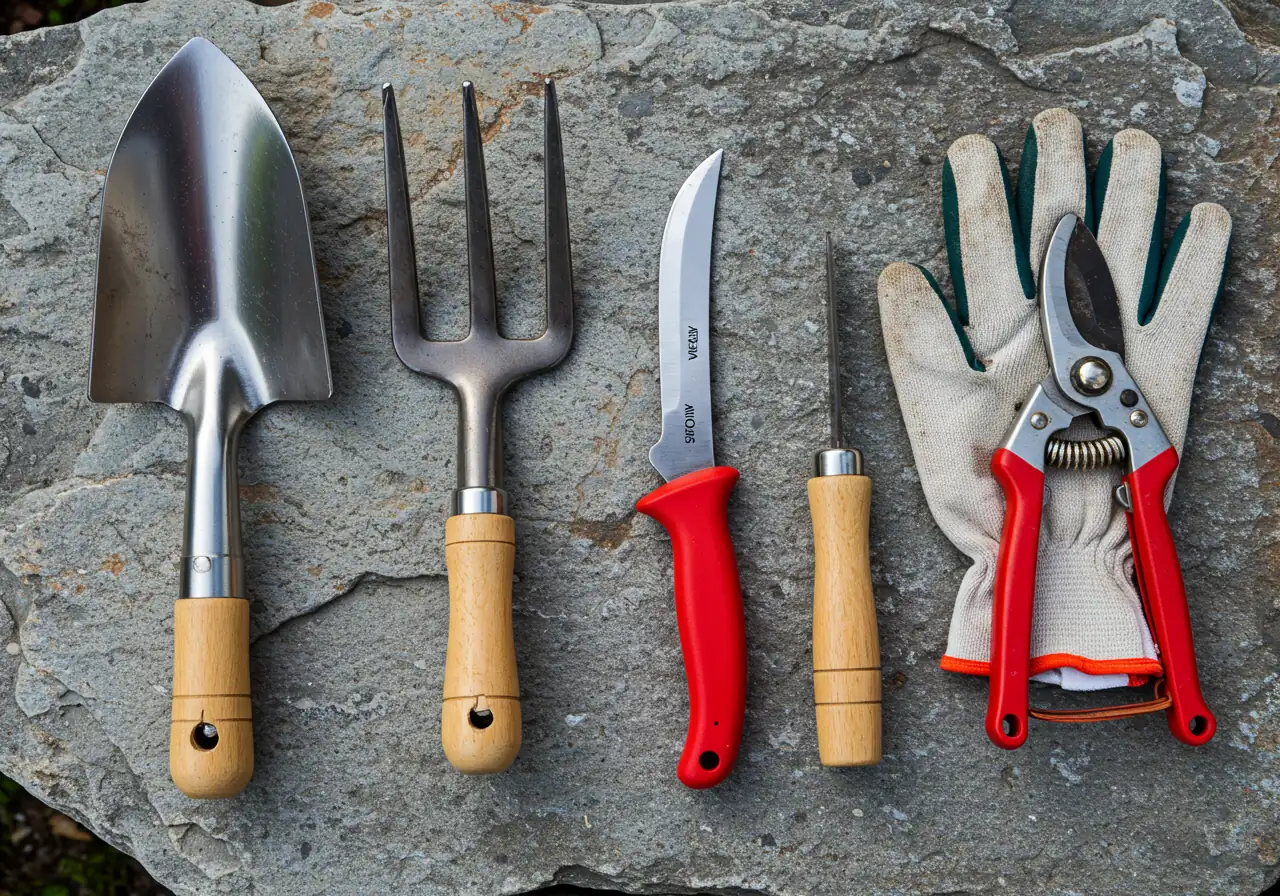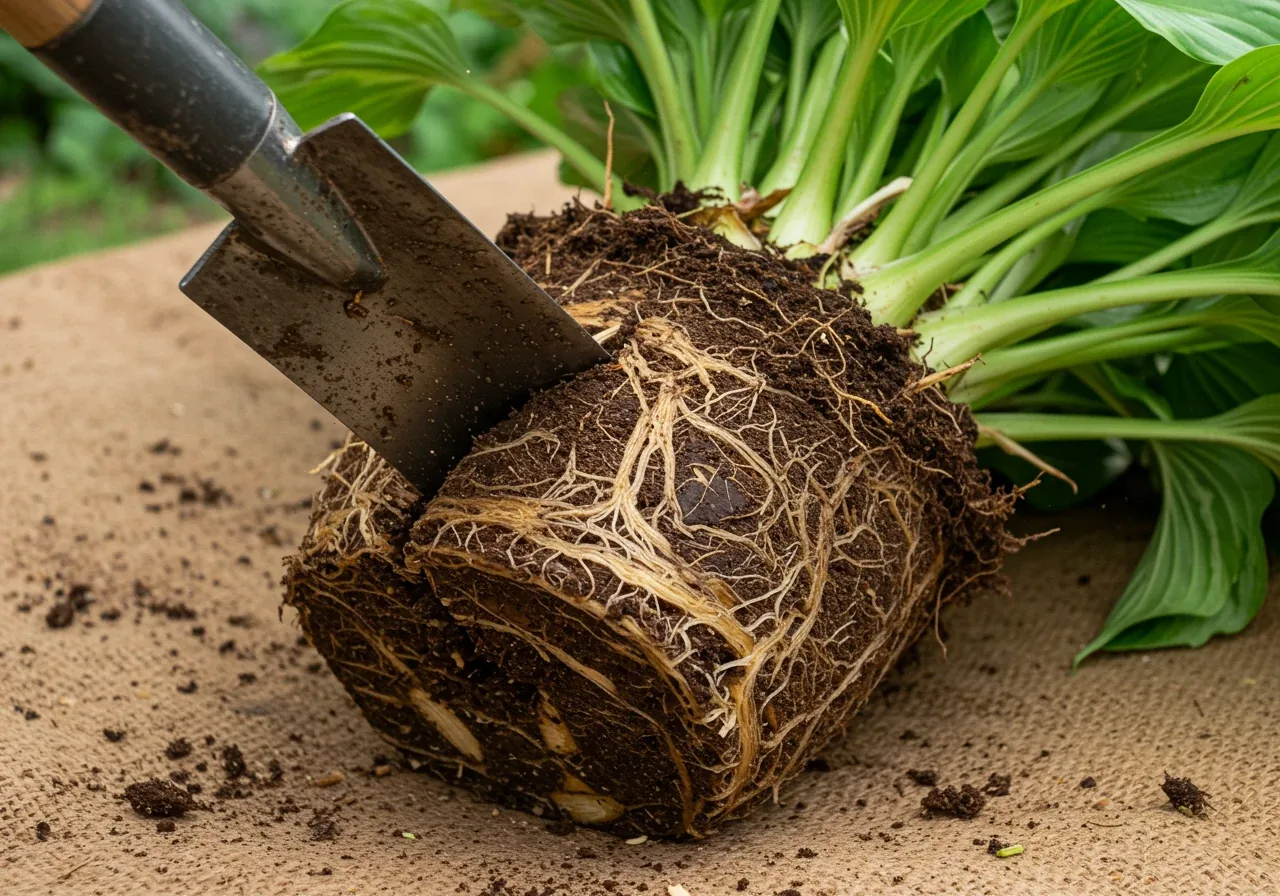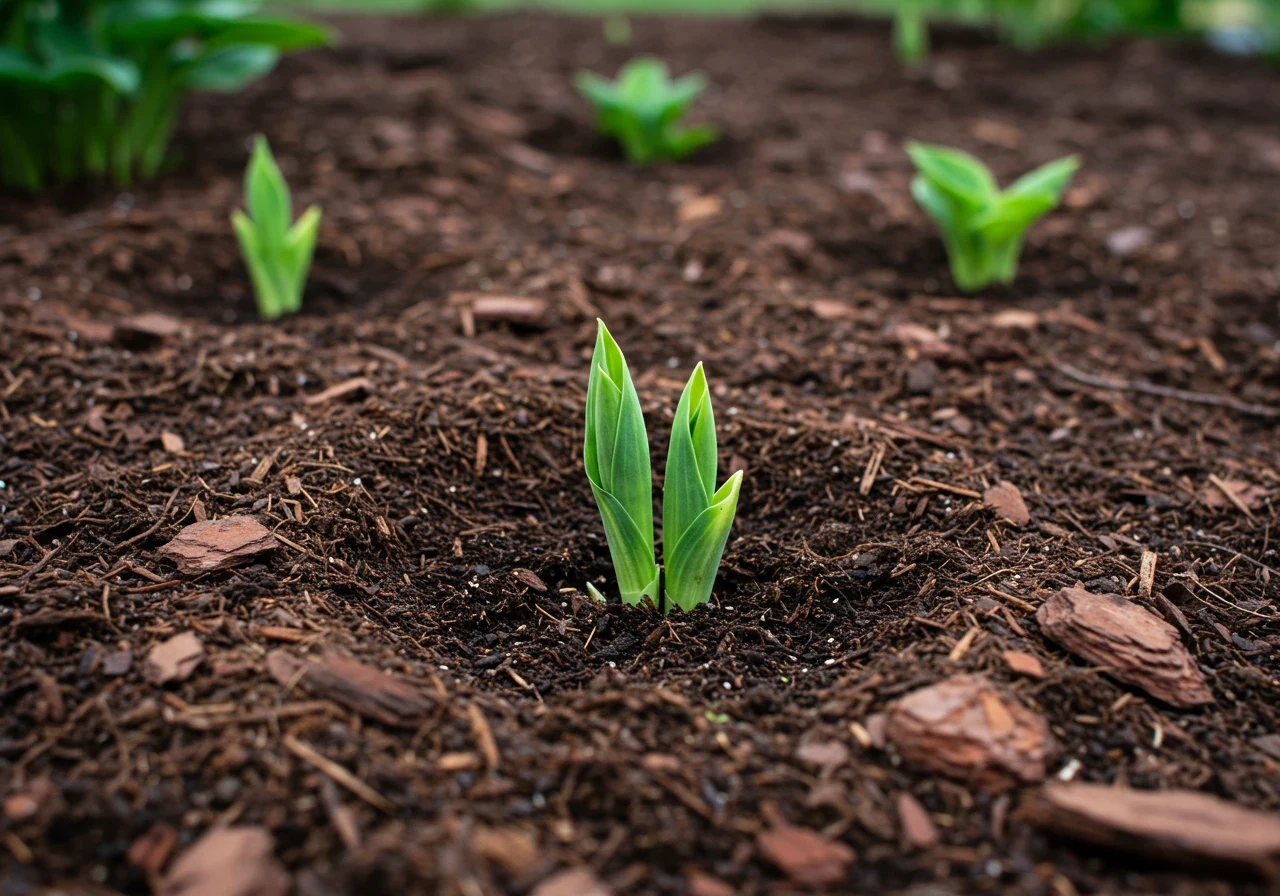Stop Manotick Plant Chaos: Fall Perennial Division Tips
Quick Summary: Fall Perennial Division
- Why Divide? Improve plant health, increase blooms, control size, and get free plants.
- Best Time (Ottawa): Late August to late September (allow 4-6 weeks before hard freeze).
- Who to Divide Now: Spring/early summer bloomers (Peonies, Hostas, Daylilies).
- Key Steps: Lift clump, separate sections (with roots/buds), replant at same depth, water well, mulch after light frost.
Introduction: Escaping the Perennial Pandemonium in Manotick

Is your Manotick garden staging a bit of a hostile takeover? Are those once-lovely perennials now elbowing each other out like shoppers on Black Friday? It happens to the best of us gardeners! Over time, many beautiful flowering plants can get a little too comfortable in their garden beds, becoming overcrowded, weak in the center, or just plain gigantic. This perennial pandemonium doesn't just look messy; it can actually harm your plants' health and reduce those beautiful blooms we all love.
Don't despair, fellow Ottawa green thumbs! Fall is actually a fantastic time to tackle this common gardening challenge. Dividing your perennials gives them room to breathe, encourages vigorous new growth next spring, and hey – you get free plants to expand your landscaping or share with neighbours in places like Greely or Barrhaven! This guide is packed with simple, practical tips specifically for gardeners navigating the cooler autumn conditions right here in the Ottawa area. We'll walk you through exactly how to divide your favourite perennials this fall, ensuring your garden looks refreshed and ready for another beautiful season. Let's grab our trowels and get digging!
Why Bother Dividing Perennials? More Than Just Tidying Up!
Okay, let's be honest. Digging up chunks of your garden might sound like extra work when you're already thinking about fall chores. You might look at that big clump of hostas or daylilies and think, "They look fine, why mess with them?" But trust us, dividing perennials is one of the best things you can do for your garden's long-term health and beauty, especially here in Ottawa where we want to make the most of our growing season! It's way more than just neatening the edges.
Think of it like this:
- Plant Health Power-Up: Over time, many perennials get overcrowded. The center of the clump can die out, leaving a doughnut shape. Roots get tangled, competing fiercely for water and nutrients. Dividing gives each new section fresh space to grow strong roots and lush foliage. Healthier plants are also better equipped to survive our chilly Ottawa winters. Better roots mean better water uptake, which is crucial, though hopefully, you're already doing routine Manotick Irrigation Checks to Save Water in Summer.
- More Flowers, Please! A crowded plant often puts its energy into just surviving, not showing off. Dividing rejuvenates the plant, often leading to more and bigger blooms next season. Who doesn't want more flower power?
- Controlling the Chaos: Some plants are enthusiastic spreaders (we're looking at you, Bee Balm!). Dividing keeps them in their designated spot, preventing them from bullying their more reserved neighbours in your Manotick or Barrhaven garden beds. It helps maintain your beautiful garden design.
- Free Plants! (The Best Kind): This is the big bonus! Every division you make is essentially a free plant. You can use these to fill gaps elsewhere in your garden, start a new bed, or share the plant love with friends and neighbours. What a great way to expand your landscaping without spending extra cash! Find inspiration for new planting areas by checking out some amazing garden transformations.
- Improving Your Soil: When you dig up a perennial clump, it's the perfect opportunity to amend the soil in that spot. Adding compost improves structure and fertility. This is especially helpful if you're dealing with tricky ground; improving drainage is key, much like when creating a Manotick Rain Garden in Clay Soil for Better Drainage. Proper soil preparation is vital.
Dividing is a key task often included in fall preparations. Just like getting your lawn ready, giving your perennials attention sets them up for success. Think of it as part of your essential Manotick Fall Cleanup for Winter Lawn Prep. It’s a vital step covered in any good Manotick Fall Cleanup and Winter Prep Guide.
So, while it takes a bit of elbow grease, dividing perennials pays off big time with healthier, more beautiful plants and even freebies for your garden. If the task seems a bit much, remember there are professional Landscaping and Gardening Services available to help keep your Ottawa garden thriving.
Timing is Everything: Nailing Fall Division in the Ottawa Valley
Okay, let's talk timing! When it comes to dividing perennials in the Ottawa Valley, getting the schedule right is super important. Unlike grabbing a beavertail whenever the craving hits, dividing plants has a specific window for success, especially with our dramatic seasons! Mess up the timing, and your newly split plants might struggle.
Late August - Late September
This is the **sweet spot** for fall division in the Ottawa region (Manotick, Greely, etc.). Aim for this window.
Why This Timing?
Gives new divisions crucial **4-6 weeks** to establish roots before the ground freezes solid.
Nature's Cues
Look for cooler temperatures (especially nights) and plants looking slightly tired post-bloom.
Fall Division Pros
Cooler air, reliable rain reduce stress. Warm soil aids root growth. Frees up spring time. Ideal for early bloomers.
Fall Division Cons
Not for fall bloomers (asters, mums) or most grasses. Risk if early deep freeze occurs. Some plants dislike winter wetness post-division.
Simple Rule of Thumb
Blooms *before* Canada Day? Fall division is likely okay. Blooms *after* Canada Day? Consider spring division.
Getting the timing right prevents sad, struggling plants and helps maintain the vibrant look you love. Witnessing how proper care rejuvenates a garden bed is always rewarding; you can see examples of refreshed spaces in these amazing Garden Transformations. Preparing the ground well is key; good Soil Preparation Techniques make a huge difference for these new divisions. If juggling fall chores feels overwhelming, remember that help is available. Many comprehensive Landscaping and Gardening Services include perennial care. Specifically, incorporating division into a larger seasonal tidy-up, like a dedicated Manotick Yard Cleanup Service, can save you time and ensure the job is done right. Unsure about the timing or scale for your specific garden? Planning helps, and reviewing feedback on estimates and project planning can offer insights into scheduling garden work effectively in our region.
For more information on local climate patterns relevant to gardening, check out resources from [Reputable Ottawa Gardening Resource 1: Agriculture Canada] or the [Reputable Ottawa Horticultural Society Link: Garden Ontario].
Friend or Foe? Which Ottawa Favourites Love Fall Division (and Which Don't)
Okay, fellow Ottawa gardeners, let's talk plant personalities! Just like people, some of your perennial pals love being disturbed in the fall, while others get downright grumpy about it. Knowing who's who can make a big difference in how well they bounce back next spring. Dividing isn't just busy work; it's about understanding what helps each plant thrive in our specific climate, whether you're gardening in Nepean or tending beds out in Richmond.
Best Bets for Fall Division (Late Aug - Late Sep)
These plants generally respond well to being divided after they finish blooming but before winter sets in hard:
- Peonies: Give them space now for stunning spring blooms.
- Daylilies (Hemerocallis): Tough and forgiving, they divide easily in fall.
- Hostas: Dividing prevents the centers from dying out.
- Siberian Iris: Less fussy than Bearded Iris about fall division.
- Bleeding Hearts (Dicentra): Divide after their foliage starts to yellow.
- Astilbe: Prefers moist soil, so fall's cooler temps help.
- Lady's Mantle (Alchemilla): Easy to divide after flowering.
Better Left for Spring Division (After Ground Thaws)
These plants prefer being divided in the spring to avoid stress before winter or because they bloom late:
- Fall Asters & Mums (Chrysanthemums): Let them finish blooming!
- Ornamental Grasses: Most resent fall division and risk rotting over winter.
- Coneflowers (Echinacea): Can be sensitive to winter wetness after dividing.
- Sedum 'Autumn Joy' (Hylotelephium): Flowers late and prefers spring handling.
- Butterfly Weed (Asclepias tuberosa): Has a deep taproot that dislikes disturbance.
- Lavender: Better pruned in spring, not divided aggressively.
Dividing these plants correctly is a key part of garden maintenance and can dramatically improve your beds over time – you can see the amazing difference proactive care makes in these Garden Makeover Examples. Remember, when you dig up a clump, it’s a perfect time to improve the soil with compost. While dividing helps fill gaps, if you're facing larger bare patches, sometimes Fresh Sod Installation for a Perfect Lawn is a better solution for lawn areas.
Unsure about a specific plant? A quick search online or checking the plant tag is always wise. Dealing with divisions can get messy, often generating debris. It's a task that fits perfectly within broader fall tidying, whether you handle it yourself or use a comprehensive Ottawa Fall Yard Cleanup Service. Even smaller communities benefit from focused tidying, like the specialized Marionville Garden Clean Up Service. And rest assured, if you choose professional help, responsible companies value your trust; you can read about How We Protect Your Privacy if you have any concerns. Happy dividing!
The Great Divide: Your Step-by-Step Guide to Perennial Success

Alright, garden warriors, it's time to roll up those sleeves and get ready for some plant multiplication! Dividing perennials might sound like major garden surgery, but don't sweat it. It’s actually pretty simple and incredibly rewarding. Think of yourself as a benevolent garden ninja, giving your favourite plants some breathing room and creating freebies in the process! Here’s how to tackle the great divide, step-by-step, right here in Ottawa.
Step 1: Gear Up and Prep the Patient
First things first, gather your tools. You don't need fancy gadgets, just the basics:
- A sturdy pointed shovel or garden spade (your main digging tool).
- A garden fork (sometimes two are handy for prying roots apart).
- A sharp knife, an old serrated bread knife, or even a small hand saw for tough roots. Make sure it's clean!
- A tarp or wheelbarrow to contain the mess (trust us on this one).
- Watering can or hose.
- Compost or garden soil amendments (check our guide on material selection for tips).
Pro Tip: Water the perennial you plan to divide thoroughly a day or two beforehand. This makes the soil easier to dig and hydrates the plant, reducing transplant shock. Also, prepare the new planting holes before you dig up the main plant. Nobody likes waiting around with their roots exposed!
Step 2: The Big Lift
Now, gently approach the chosen plant. Start digging around the entire perimeter of the clump, about 6-12 inches away from the base, depending on its size. You want to get under the root ball, not just slice down through it. Carefully work your shovel or fork underneath and gently pry the whole clump upwards. Try to keep as much of the root system intact as possible. Lift it out of the ground and onto your tarp or into the wheelbarrow. Whew, the hard part is done!

Step 3: Operation Divide!
Okay, time for the actual dividing. How you do this depends on the plant's root system:
- Easy Peasy (Spreading Roots): Plants like Daylilies, Bee Balm, or some Sedums often have fibrous roots that can be teased apart by hand. If it's a bit stubborn, try sticking two garden forks back-to-back into the center of the clump and gently pulling the handles apart to pry it into sections.
- Tough Cookies (Clumping Roots): Hostas, Astilbe, and some Ornamental Grasses (though remember, divide grasses in spring!) form dense clumps. Lay the clump on its side and use your sharp knife, spade, or saw to cut it into viable sections. Make sure each new piece has a good chunk of roots and several healthy shoots or buds (called "eyes"). Aim for divisions about the size of your fist or a bit larger. Don't be shy; sometimes you need to put some muscle into it!
- Woody Crowns & Taproots: Plants like Peonies or Bleeding Hearts have tougher crowns. Use a clean, sharp knife to cut sections, ensuring each piece has at least 3-5 prominent buds ('eyes') and healthy roots attached. Be precise! Plants with deep taproots (like Butterfly Weed) generally hate being divided, so avoid them if possible.
Step 4: Replanting Your New Recruits
Take your new divisions and trim off any damaged roots or dead/yellowing foliage – this helps the plant focus energy on root growth. Pop each division into its pre-dug hole, making sure the crown (where the stems meet the roots) is at the same soil level it was originally. Don’t plant too deep! Backfill the hole with soil, gently firming it around the roots to remove air pockets. Adding some compost to the backfill soil gives them a great start. This might be a good time to consider professional garden installation if you're creating new beds.
Step 5: Tuck Them In
Water your newly planted divisions thoroughly. This settles the soil and provides essential moisture. Keep them consistently watered (but not soggy) until the ground freezes – this is crucial for root establishment before our Ottawa winter sets in. Adding a 2-3 inch layer of mulch (like shredded bark or leaves) around the base helps conserve moisture and insulates the soil. Read more about mulching and edging best practices.
Dealing with the Aftermath:
You'll likely have some plant debris – old stems, maybe some weak center parts of the clump you discarded. Healthy plant material can go right into your compost bin! If you have more divisions than space, share the plant love with neighbours in Barrhaven or friends across the city! Managing the leftover soil and plant bits is often part of a bigger seasonal tidy-up. If the task generates more mess than you want to handle, consider booking a fall Ottawa Garden Clean Up Service to take care of the leftovers. A comprehensive Ottawa Property Cleanup Service can handle everything from leaf removal to garden debris. Whether it's a large estate or a standard City Yard Cleanup Service you need, tidying up after dividing helps keep your whole landscape looking sharp. Even specific areas like Marionville have options, such as a dedicated Marionville Yard Cleanup Service to assist. And remember, getting rid of the clutter isn't just about looks; a full Ottawa Yard Cleanup Service helps prevent pests and diseases from overwintering. Find us easily via our Google Business Profile!
There you have it! You’ve successfully divided your perennials, rejuvenated your plants, and maybe even got some freebies. High five, garden ninja!
Visualizing Success: Root Establishment Before Freeze
Giving your divisions enough time to establish roots before the ground freezes is critical. Here's a simple visualization showing the relative importance of timing:
Chart illustrates conceptual survival/establishment rate based on division timing in Ottawa.
Ottawa Soil & Winter Prep: Giving Your Divisions a Fighting Chance
Okay, you’ve successfully performed plant surgery – high five! Now, let's talk about giving your new perennial divisions the best possible start right here in Ottawa, especially focusing on our… unique soil and preparing them for the winter ahead. Getting this right is crucial for their survival and spring comeback.

Let's face it, Ottawa soil can be a bit of a character. We often deal with heavy clay (great for pottery, less great for drainage) or sometimes pockets of sand. Neither is perfect for delicate new roots trying to establish before the ground freezes solid. Heavy clay stays wet and cold, potentially rotting roots, while sandy soil drains too quickly and can leave roots exposed during freeze-thaw cycles. So, what’s a gardener in Barrhaven or Metcalfe to do? Amend, amend, amend!
When you plant your new divisions, mixing a generous amount of compost into the backfill soil is your secret weapon. Compost works wonders:
- For Clay Soil: It improves drainage and aeration, preventing roots from sitting in icy water. No more soggy feet!
- For Sandy Soil: It helps retain moisture and adds vital nutrients.
- Overall: It provides a nutrient boost for strong root development before winter dormancy. Good soil preparation is foundational.
Think of it as giving your plants a cozy, nutrient-rich blanket underground.
Now, let's talk over ground prep – mulching! After planting and watering your divisions well, wait until after the first light frost, but before the ground freezes solid (usually late October or early November around here). Apply a 2-3 inch layer of organic mulch like shredded bark, straw, or chopped leaves around the base of the plants. Why wait? Mulching too early can keep the soil too warm, preventing the plant from going dormant properly.
This fall mulch layer isn't primarily for moisture (winter usually handles that) but for insulation. It helps:
- Regulate Soil Temperature: Prevents the damaging freeze-thaw cycles that can literally push new, shallow-rooted plants right out of the ground – that’s called frost heave, and it’s a real pain!
- Protect the Crown: Shields the base of the plant from harsh winter winds and extreme cold.
Proper soil prep and mulching significantly increase your divisions' chances of surviving our Ottawa winters. It’s a key part of fall garden care. If you find yourself overwhelmed with fall chores, remember that professional help is available. Many services offer targeted assistance, like a specific Metcalfe Property Cleanup Service or a general Ottawa Garden Clean Up Service to handle mulching and debris removal. Even smaller urban spaces can benefit from a dedicated City Garden Clean Up Service or specialized City Garden Maintenance Service. If you're considering hiring help, it's always wise to understand the scope of work; most reputable companies like Clean Yards provide clear details, often found within their service information or standard Terms and Conditions. Still have questions about prepping your specific garden beds? Feel free to Contact Us for advice or check our About Us page to learn more!
Highlight Box: Fall Division Fast Facts
Need the quick version on dividing perennials this fall? Here are the key things to remember for success in your Ottawa garden:
- Why Do It? More Blooms & Health! Dividing isn't just tidying up. It prevents overcrowding, rejuvenates tired plants for better blooms next year, controls aggressive spreaders, and gives you free plants for your landscaping!
- Timing is Crucial in Ottawa: The sweet spot is late August through September (maybe early October). Your goal is giving divisions 4-6 weeks to establish roots before the ground freezes solid. Don't wait too long, or they won't survive our winter!
- Pick the Right Plants: Fall is perfect for dividing spring and early summer bloomers like Peonies, Hostas, Daylilies, and Siberian Iris. Hold off on fall bloomers (Mums, Asters) and most ornamental grasses until spring.
- The How-To Basics: Dig up the entire clump, gently pry or cut it into fist-sized sections (each needs roots and buds!), replant immediately at the same soil depth, and water thoroughly. Amending the soil with compost helps immensely.
- Winter Protection is Key: Water new divisions regularly until freeze-up. After the first light frost but before the ground freezes hard, apply a 2-3 inch layer of mulch (like shredded leaves or bark). Proper Mulching and Edging helps insulate the soil and prevent frost heave.
- It's Part of Overall Care: Dividing fits perfectly into your fall cleanup routine. Remember that good Garden Maintenance and preparing your beds now sets the stage for next spring, complementing efforts like fall Lawn Care. If the whole fall checklist feels like too much, professional help is available, like the dedicated Marionville Property Cleanup Service for specific areas. Check service details or Terms and Conditions for scope. Need help? Consider our Thank You page might be relevant after a service.
FAQs: Your Burning Perennial Questions (Manotick & Ottawa Edition)
Dividing late in Ottawa is risky as roots need 4-6 weeks before a hard freeze. They might struggle! Give them a thick layer of mulch (3-4 inches) after a light frost for extra insulation, and water well until the ground freezes. Hope for good snow cover! Next year, aim for September division for better results.
Clay soil needs help! Amend the planting hole generously with compost before planting your divisions. This improves drainage and adds nutrients, stopping roots from sitting in cold water. Avoid planting the crown too deep. If soil issues are widespread, specialized help like a Metcalfe Garden Clean Up Service might offer insights relevant to challenging local conditions.
While getting free plants is great, don't go too small! Each division needs enough roots and at least 3-5 healthy buds or shoots ('eyes') to survive our Ottawa winter and thrive next spring. Think roughly fist-sized as a minimum. Tiny divisions struggle to establish quickly. Quality over quantity leads to better success.
You don't have to, but it's smart! Overcrowded plants often have fewer blooms and weak centers. Dividing rejuvenates them for better health and flowering – think preventative medicine for your garden! It's a key task in overall Garden Maintenance that keeps plants vigorous and your landscape looking its best for years to come.
The delightful "problem" of free plants! Offer extras to neighbours in Barrhaven or friends across Ottawa. Local garden groups online are often happy to take donations. If you have too many or associated debris, managing the surplus can be part of seasonal tidying. A comprehensive Property Clean Up can often handle excess green waste effectively.
It depends! Basic fall cleanups usually focus on leaves, branches, and general debris removal. Dividing perennials is more specific horticultural work. Always confirm what's included. If you need division plus leaf removal and tidying, ask if it can be added or seek a more inclusive package like a City Property Cleanup Service that addresses garden beds too.
Conclusion: Transform Your Garden from Chaos to Calm
So there you have it! No more perennial pandemonium turning your beautiful garden beds into a botanical free-for-all. Dividing those overgrown clumps this fall isn't just about tidying up; it's your secret weapon for transforming chaos into calm. Remember the fantastic benefits:
- Stronger, healthier plants ready to face our Ottawa winter.
- More vibrant blooms come springtime.
- Keeping those enthusiastic spreaders politely in their place.
- Best of all – free plants to expand your landscaping or share!
Taking a little time for fall division now, whether you're gardening in Manotick or over in Barrhaven, pays off hugely next season. It's a key step in smart garden maintenance that sets you up for success.
Feeling like this task is better left to the pros, or just tight on time with fall chores piling up? We get it! Our expert gardening crews are ready to lend a hand across the Ottawa region, including neighbourhoods like Greely and Nepean. We can handle perennial division as part of a comprehensive fall cleanup, ensuring your plants get the professional care they need to thrive. Let us tackle the digging! You can explore our range of Landscaping and Gardening Services to see how we can help rejuvenate your yard.
Want more local gardening wisdom specifically for our climate? Check out other helpful articles on our Blog or Contact Us directly with your specific questions about dividing perennials or other fall landscaping tasks. Go forth and conquer that garden clutter – happy dividing!

